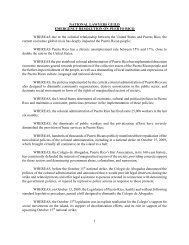NLGRev 68-2[1].indd - National Lawyers Guild
NLGRev 68-2[1].indd - National Lawyers Guild
NLGRev 68-2[1].indd - National Lawyers Guild
Create successful ePaper yourself
Turn your PDF publications into a flip-book with our unique Google optimized e-Paper software.
76 national lawyers guild review<br />
in the legal industry.” 77 This example reinforces that legalization not only fails<br />
to reduce violence against women, it is often used as a tool to perpetuate it.<br />
The Netherlands experiment: The failure of decriminalization<br />
It is estimated that about 30,000 people “work” in prostitution in the Netherlands.<br />
78 The prostitution industry rakes in one hundred million dollars per year. 79<br />
The Netherlands’ strategy to eliminate trafficking was to decriminalize prostitution<br />
and initiate a license system for brothel operators handled by the municipalities. It<br />
was seen as a way to stop ignoring the brothels and instead admit their existence.<br />
The goal of decriminalization and regulation of prostitution was to raise working<br />
conditions for sex workers, make the sex industry more transparent, and allow the<br />
police to monitor the situation effectively. 80<br />
The Netherlands passed the “Abolition of the Ban of Brothels” in 2000. 81<br />
The purpose of the law was to more closely monitor and regulate the approximately<br />
2,000 pre-existing brothels and sex-clubs in the country. Lawmakers<br />
believed the law would work against the so-called “involuntary” prostitution<br />
and the exploitation of minors and undocumented immigrants in prostitution,<br />
and other unacceptable forms of sexual exploitation. This law was supposed<br />
to make it unattractive and impossible to employ undocumented immigrants<br />
as prostitutes, thus diminishing trafficking to the Netherlands. 82 It has been<br />
a complete failure. The alleged goal of legalization—the prevention of<br />
trafficking—has not been accomplished. Following the Hague Ministerial<br />
Declaration on European Guidelines for effective measures to prevent and<br />
combat trafficking in women for the purpose of sexual exploitation from<br />
1997, the Netherlands appointed a <strong>National</strong> Reporter on Traffic of Persons,<br />
Mensenhandel. 83 This bureau estimated the number of victims of human<br />
trafficking in the Netherlands to be about 3,000 to 3,500 persons in 2003. 84<br />
The central problem is in the economics of the sex industry. A story in<br />
January 2006 from the UN Information Service welcomes a new campaign<br />
in the Netherlands to identify victims of trafficking who have been forced<br />
into prostitution. 85 In the report, it is noted, “Victims of trafficking suffer the<br />
most cruel, degrading and violent treatment. I encourage people to support<br />
this important campaign and provide information to their local police or<br />
through the hotline. I hope other European countries will also do more to<br />
end sexual exploitation.” 86 What the speaker fails to realize is that the State<br />
cannot end sexual exploitation so long as it endorses prostitution. Prostituted<br />
women and girls will always have to be procured anew. If demand is not<br />
addressed, there will never be enough supply of women as “product,” and<br />
trafficking will continue.<br />
It is critical to point out that even though the international recruitment<br />
of persons for “sex workers” is criminalized, domestic or “voluntary”


![NLGRev 68-2[1].indd - National Lawyers Guild](https://img.yumpu.com/30820772/14/500x640/nlgrev-68-21indd-national-lawyers-guild.jpg)













